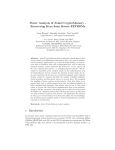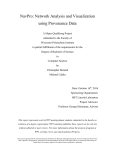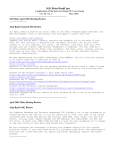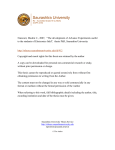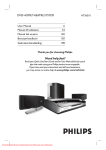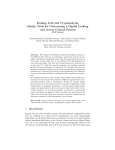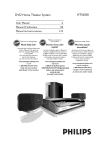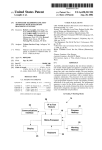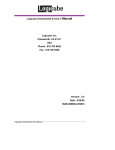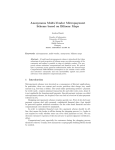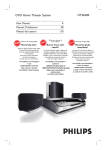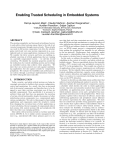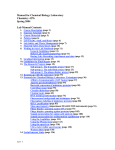Download Securing Cloud Hypervisors without Massive Re
Transcript
Delusional Boot: Securing Cloud Hypervisors
without Massive Re-engineering
Anh Nguyen† , Himanshu Raj∗ , Shravan Rayanchu‡ , Stefan Saroiu∗ , and Alec Wolman∗
†
UIUC, ‡ University of Wisconsin, and ∗ Microsoft Research
Abstract: The set of virtual devices offered by a hypervisor to its guest VMs is a virtualization component ripe with
security exploits – more than half of all vulnerabilities of
today’s hypervisors are found in this codebase. This paper
presents Min-V, a hypervisor that disables all virtual devices
not critical to running VMs in the cloud. Of the remaining
devices, Min-V takes a step further and eliminates all remaining functionality not needed for the cloud.
To implement Min-V, we had to overcome an obstacle:
the boot process of many commodity OSes depends on legacy
virtual devices absent from our hypervisor. Min-V introduces
delusional boot, a mechanism that allows guest VMs running commodity OSes to boot successfully without developers having to re-engineer the initialization code of these
commodity OSes, as well as the BIOS and pre-OS (e.g., bootloader) code. We evaluate Min-V and demonstrate that our
security improvements incur no performance overhead except for a small delay during reboot of a guest VM. Our reliability tests show that Min-V is able to run unmodified Linux
and Windows OSes on top of this minimal virtualization interface.
Categories and Subject Descriptors
Protection]: Security kernels
1.
D.4.6 [Security and
Introduction
Cloud providers rely on commodity virtualization systems
to enforce isolation among their customers’ guest VMs. Any
vulnerability that could be exploited by a guest VM has serious consequences for the cloud because it can lead to corrupting the entire cloud node or to launching DoS attacks
on other guest VMs. We manually examined all such vulnerabilities found in a few online security databases [25, 27,
34, 40] and we discovered 74 such vulnerabilities in Xen,
Permission to make digital or hard copies of all or part of this work for personal or
classroom use is granted without fee provided that copies are not made or distributed
for profit or commercial advantage and that copies bear this notice and the full citation
on the first page. To copy otherwise, to republish, to post on servers or to redistribute
to lists, requires prior specific permission and/or a fee.
EuroSys’12, April 10–13, 2012, Bern, Switzerland.
c 2012 ACM 978-1-4503-1223-3/12/04. . . $10.00
Copyright Xen
VMWare ESX
VMWare ESXi
Total
# of security vulnerabilities
in entire codebase
31
23
20
74
# of security vulnerabilities
in virtual devices codebase
20
17
15
52
# of security vulnerabilities
found in devices Min-V removes
16
15
13
44
Table 1. Security Vulnerabilities in Commodity Virtualization Systems. These vulnerabilities were collected from
four online databases [25, 27, 34, 40].
VMWare ESX, and VMWare ESXi, combined. Over 70%
of them (52 security vulnerabilities) were present in these
systems’ virtualization stacks, that is in the code implementing the virtualized I/O offered to each guest VM. Table 1
presents a breakdown of these findings.
These statistics suggest that minimizing the codebase implementing the virtualization stacks of these systems can go
a long way towards preventing attacks from rogue VMs. We
argue that the nature of cloud computing lends itself to making these virtualization stacks much smaller and thus more
safe. First, cloud computing VMs have fewer I/O device requirements than general-purpose VMs. For example, HyperV offers up to 39 virtual devices to service its guests; these
include a graphics card, a serial port, a DVD/CD-ROM, a
mouse, a keyboard, and many other such devices that cloud
VMs make no use of. In our experience, most cloud VMs
only require processing, disk storage, and networking functionality from the underlying virtualization stack. Second,
much of a virtual device’s codebase is not required for handling the common cases of device use. For example, large
swaths of code handle device initialization and power management, operations that are not critical to cloud guest VMs.
In contrast, the code handling common device operations
(e.g., reads and writes in case of a disk) is only a small piece
of the overall virtual device’s codebase. Finally, eliminating
those virtual devices that emulate legacy hardware though
low-level interfaces reduces complexity.
We present the design and implementation of Min-V, a
cloud virtualization system based on Microsoft’s Hyper-V.
Min-V disables all virtual devices not critical to running
VMs in the cloud and offers just nine virtual devices out
of a set of 39. For the remaining devices, Min-V takes a step
further and virtualizes only their common functionality without handling device initialization or power management. To
implement Min-V, we had to overcome a significant challenge: many commodity operating systems, such as generic
configurations of Linux and Windows, fail to boot on our
hypervisor. This occurs for two reasons: (1) the BIOS or the
operating systems themselves check for the presence of several legacy devices at boot time, devices that are not critical
to cloud VMs; and (2) they perform device initialization and
power management, functionalities deliberately disabled in
Min-V. One possibility is to rewrite commodity BIOSes and
OSes. However, such an approach is challenging because it
requires a significant amount of effort (numerous man-years
of engineering) in a challenging development environment
(low-level, pre-OS boot). Even worse, for cloud providers
such an alternative may not be viable because they may lack
source code access to the specific commodity OS a customer
wants to boot in their environment.
As an alternative, Min-V sidesteps these engineering
challenges with delusional boot. Delusional boot provides
a full set of devices with complete functionality to the OS
only during the boot process. Later on, it disables the noncritical devices and it replaces the critical ones with a set of
barebones virtual devices that only offer common case functionality. With delusional boot, the guest VM is first booted
using a normal configuration of Hyper-V with many of the
virtual devices enabled, on a special node isolated from the
rest of the datacenter. After the guest OS has finished booting, Min-V takes a VM snapshot, migrates it to a node in the
datacenter, and restores the guest VM on the Min-V hypervisor that supports only the set of barebones virtual devices.
Min-V uses a new TPM-based software attestation protocol
that allows us to implement delusional boot using off-theshelf servers and switches.
While delusional boot allows Min-V to successfully boot
commodity OSes, guest OSes might still attempt to invoke
functions via one of the removed devices. Min-V handles
such accesses safely by returning a legitimate hypervisor
error code (0xFF in Hyper-V). This simple error handling
is sufficient to avoid crashing any of the commodity OSes
(Windows 7, Windows XP, and Ubuntu) we tested. While
these OSes panic during boot if they detect missing or
faulty hardware, once running these OSes are often hardened
against hardware errors that manifest gracefully through an
error code. The graphics card best illustrates this behavior
– although several commodity OSes refuse to boot if they
lack a graphics card, they do not crash when the virtualized
graphics hardware starts returning 0xFF at runtime. We used
several workloads and a commercial reliability benchmark
to investigate the robustness of delusional boot, and all three
OSes tested remained stable throughout our experiments.
Of the 52 vulnerabilities described earlier, we estimate
that removing virtual devices not needed in the cloud would
eliminate at least 44 of them. Our estimate is conservative;
for some of these vulnerabilities, it was not specified what
device they belong to or whether they appear in the emulated
portion of a device (such portions are removed by Min-V).
Since Min-V also minimizes the functionality of the remaining devices, it is possible that even more vulnerabilities are
eliminated; however, quantifying this effect on the data is
much harder.
Our evaluation shows that Min-V reduces virtual device
interfaces by 60% based on counting the number of lines
source code in Hyper-V. This reduction in the attack surface
is done with no performance penalty during the VM runtime.
Min-V’s sole performance overhead occurs when the guest
VM needs to reboot, a relatively infrequent operation. In
the case of Ubuntu, rebooting a guest VM in Min-V has
an overhead of less than a minute in addition to the two
minutes spent to boot the OS alone. We also evaluate MinV’s reliability using an industrial reliability benchmark and
we found that all tested OSes remain stable.
2.
Design Alternatives for Secure Cloud
Virtualization
The need for secure virtualization for the cloud is greater
than ever. Cases of cloud customers’ software turning rogue
have already been documented. For example, Amazon’s EC2
machines have been used to send spam [21] and to launch
denial-of-service attacks on other Amazon customers [3].
These examples demonstrate how cloud customers (knowingly or unknowingly) have started to abuse the cloud infrastructure for illegitimate activities. Compromised guest VMs
can become launching pads for much more serious attacks
on the cloud infrastructure or on other customers’ VMs.
The security of cloud-based architectures rests on the virtualization stack and the hypervisor remaining uncompromised and enforcing isolation between guest VMs that may
exhibit malicious behavior. One alternative is to start with
a fresh design of a virtualization stack that uses small and
well-defined paravirtualized channels for I/O communication. While such a clean-slate approach can offer strong security, it would also restrict the choice of the guest VM operating system to those that support this “special” virtual stack.
Also, commodity OSes were designed to rely on a rich set
of devices, and changing such an assumption requires serious re-engineering. Section 9 will present a more in-depth
analysis of the requirements of porting a commodity OS to
a minimal virtualization stack, and will describe why such
an alternative is expensive. Instead, here we focus on design
alternatives that continue to offer full virtualization stacks to
guest VMs. Such approaches to secure cloud virtualization
can be classified in three categories.
1. Commodity Hypervisors. Commodity hypervisors, such
as Xen, VMware, and Hyper-V, can run commodity OSes
with high performance. These systems can accommodate
many guest VMs running simultaneously with adequate performance. Their codebases are continuously upgraded to
Figure 1. Hyper-V and Min-V Architectures: In Hyper-V (on the left), the root VM offers a full set of virtual devices to the
guest VMs. The guest VMs use legacy (hardware-emulation) drivers and rich paravirtualized drivers to interact with all virtual
devices. In Min-V (on the right), the root VM disables most virtual devices. The only devices are left to support networking and
storage. The guest VMs’ drivers receive error codes if they try access non-existing devices.
offer more functionality and higher performance. Unfortunately, these improvements come with a cost: the TCBs of
these systems continue to grow. As the TCB grows, so does
the potential for security vulnerabilities.
2. “Tiny” Hypervisors. Research projects have begun to
investigate ways of offering virtualization without including
a full-fledged operating system in their TCB [13, 22, 35]. For
example, one recent project demonstrated a hypervisor with
a very small codebase, only 7889 lines of C code [22], that
is capable of running a commodity operating system. With
such a small codebase, it may be possible to use verification
to demonstrate that the system’s implementation adheres to
its specification [20]. However, to stay small, the hypervisor compromises on functionality and performance: while it
is capable of virtualizing one commodity OS, it cannot run
multiple guest VMs at the same time. Running multiple VMs
simultaneously requires implementing multiplexing and demultiplexing functionality for I/O devices, which in turn requires much more code. For example, implementing a fast
networking I/O path among co-located guest VMs requires
code that implements the functionality of a network switch;
in fact, Xen uses Linux’s iptables and ebtables packages to
implement switching. Such codebases tend to be large and
complex.
3. Disaggregated Hypervisors. Another approach is to
compartmentalize the virtualization stack in multiple isolated containers [8, 10, 24, 37, 42]. In some cases, the design of the disaggregation support is primarily driven by the
reliability needs of the virtualization stack because each isolated container can be restarted upon a crash without needing a full system reboot [42]. Nevertheless, such isolation
improves the overall system’s security because an exploit
within one container only compromises the data exposed
within that container, rather than leading to a system-wide
compromise [8, 37]. However, disaggregation only limits the
impact of security vulnerabilities, it does not reduce the size
of the TCB nor the number of vulnerabilities. Furthermore,
delusional boot can be applied to disaggregated hypervisors
as well. When such hypervisors need to boot a commodity
OS that expects a full virtualization stack, delusional boot
can simplify booting these OSes in a secure manner.
3.
Threat Model
Cloud computing raises many different security threats and
Min-V only addresses a portion of them. Our threat model
assumes that attackers can run arbitrary code inside a guest
VM with root privileges, and they have full access to the interfaces provided by the hypervisor. We make no assumptions about the configuration of the customer’s VMs, because cloud providers prefer to impose minimal requirements on their customers. These OSes can be corrupt, they
might not be upgraded or patched, and they may run rootkits
and Trojans.
Min-V improves security on behalf of both cloud providers
and cloud customers. Because cloud nodes often use the homogeneous software configurations, one exploit may compromise a large number of cloud nodes. Min-V protects
cloud customers because, if an attacker compromises a cloud
node’s root VM, the attacker can further compromise other
customers’ VMs.
Cloud computing raises additional threats that are beyond
the scope of our work. For example, a malicious administrator in a datacenter could try to compromise customers’
guest VMs or steal physical disks loaded with customers’
data. Alternatively, an administrator could be negligent in
how they handle both software and hardware, which could
lead to accidental data loss. Customers’ data could also be
subject to subpoenas [4], and data disclosures may not even
be revealed to the customers [12]. Finally, software developers may introduce backdoors into the code which could be
later exploited to gain access to guest VMs code and data.
4.
Design Goals and Design Principles
This section provides a brief overview of the Min-V architecture, its design goals, and its design principles. Figure 1
shows an architecture diagram of our system and contrasts it
with the original Hyper-V system.
4.1
Design Goals
1. Minimize the interface between the TCB and the
guest VMs. To meet this goal, Min-V disables most virtual
devices because they comprise most of the interface complexity between the TCB and the guest VMs.
2. Support legacy OSes in guest VMs. Min-V allows
customers to run any legacy OS configurations and applications inside their guest VMs. In our experiments, we
used three commodity OSes (Windows 7, Windows XP, and
Ubuntu 9.10) which are representative of typical cloud environments. To narrow the virtual devices, Min-V replaces all
remaining devices with a set of barebones virtual devices.
This is done by installing a set of drivers in each OS. In
addition of being smaller, these paravirtualized drivers offer
fast performance.
3. Minimize the performance overhead. Performance
is critical in cloud environments. Our goal is to meet the
cloud provider’s security needs without significantly impacting guest VM performance. To meet this goal, Min-V does
not add any performance overhead to running VMs. As we
will describe later, Min-V does increase the time it takes to
reboot guest VMs.
4.2
Design Principles
In the context of the above design goals, four key principles
guide our design:
1. Economy of interfaces. Any interface between the
TCB of the virtualization system and the guest VMs that is
not necessary for cloud computing should be eliminated.
2. Use high-level device interfaces rather than lowlevel ones. It is easier to secure high-level paravirtualized
interfaces than to secure low-level legacy device interfaces.
3. Isolate a cloud node from the network whenever
it executes potentially insecure operations. Whenever a
guest OS must run with a full, commodity virtualization
stack, it must be disconnected from the network to prevent compromises from spreading within the datacenter. The
node must attest that it runs a minimal virtualization stack
before being allowed to reconnect to the network.
4. Use little customization. Our solution should not require massive re-engineering of the OSes or special-purpose
hardware, such as switches that incorporate trusted computing primitives into their logic. Such solutions are often expensive and they are hard to deploy in practice.
5.
Disabling Virtual Devices
A virtualized cloud computing environment, such as MinV, differs from a general purpose virtualization platform in
that customers access guest VMs entirely via the network.
As a result, many standard physical devices on cloud servers
need not be exposed to the guest VM. For example, physical
devices such as the keyboard, mouse, USB ports, and DVD
drive serve little purpose for a cloud customer. In fact, many
of these devices have virtual equivalents that are provided
by remote desktop protocols such as RDP or VNC. For
example, a customer running Windows in a guest VM can
use RDP to redirect many devices over the network, such as
the keyboard, mouse, graphics card, printer, and even USB
storage.
In the rest of this section, we describe the types of devices
that Hyper-V provides by default to guest VMs, and how
they are powered-up and initialized. We then discuss the
device requirements of operating systems that run in the
guest VMs, and we describe the steps we took to actually
remove devices from the virtualization stack.
5.1
Hyper-V Devices
Most virtual devices provided by Hyper-V to guest VMs correspond to real physical devices, such as the NIC, the IDE
storage controller, or the keyboard controller. There are three
common approaches to implementing a virtual device: 1)
multiplexing the virtual device over the corresponding real
physical device provided by the operating system running in
the root VM; 2) emulating the hardware device entirely in
software to provide the desired functionality; and 3) providing virtualization services through a device interface. As examples of the latter category, Hyper-V provides the VMBus
device that provides a fast, shared-memory based communication channel between the root VM and a guest VM and a
heartbeat integration component that provides a way to keep
track of the guest VM’s health status.
In its default configuration, Hyper-V offers 39 virtual devices to each guest VM. This large number of devices is
not unique to Hyper-V; Xen offers a comparable number
of devices to guest VMs. For each VM, Hyper-V creates
and maintains a virtual motherboard device, which acts as
a container for the set of internal devices available to that
VM. Each virtual motherboard has a virtual device manifest,
which is just a table that enumerates all devices found on the
virtual motherboard. When a VM is initialized, each device
listed in the manifest is instantiated and attached to the virtual motherboard. Once initialization completes, the motherboard and its devices are all powered on. At this point,
virtual devices register their handlers with the hypervisor, so
that guest VM accesses to certain I/O ports and MMIO addresses are dispatched to the appropriate virtual device.
Virtual devices often have dependencies on one another.
For example, all enlightened devices depend on the VMBus
device because the VMBus implements the shared memory
bus between the root and a guest VM. Another example is
the emulated NIC which depends on the emulated PCI bus
to function properly. Figure 2 depicts the 39 devices found
in Hyper-V as nodes which are connected by directed edges
that represent dependencies. Because of these dependencies,
the order in which devices are initialized is important. For
example, the VMBus is the first device initialized by HyperV’s virtual motherboard. Similarly, the emulated PCI bus is
initialized before the emulated NIC. For Min-V, determining
these device dependencies is important because disabling a
USB HID Input
IC
HeartBeat
IC Key‐Value
Exchange
IC Shutdown
IC Timesync
Dynamic
Memory
IC Volume
Shadow Service
PIT
PC Speaker
P/S 2
Keyboard
VMBus
Synthetic NIC
Synthetic
SCSI Controller
Keyboard
Controller
RTC
CMOS
P/S 2 Mouse
Super IO
SCSI Harddrive
BIOS
Loader
Synthetic
Mouse
Serial
Controller
IoAPIC
ISA Bus
DVD‐Rom
Emulated
IDE Controller
S3 Video
Controller
PCI Bus
Video
Monitor
ISA DMA
Controller
PIIX4 Power
Management
PIC
CD‐Rom
Serial
Ports
Floppy
Controller
IDE Harddrive
Synthetic
Video
Virtual Motherboard
Emulated NIC
Floppy
Disk
Figure 2. Virtual stack dependencies. Devices that we simply removed from Min-V have a dark background. The stripe
background represents devices that Windows 7 or the virtual BIOS check for at boot time, and we successfully “removed” them
with delusional boot. Devices with a white background are those remaining in our system. Arrowed lines show virtual device
dependencies, and the dashed line represents a dependency we manually removed.
virtual device cannot be done unless all its dependent devices are also disabled. Next, we describe how we determined device dependencies.
5.2 Determining Device Dependencies
We use three heuristics to determine device dependencies in
Hyper-V. Each heuristic allows us to test for the presence or
absence of a dependency between two devices. While each
heuristic has different shortcomings (e.g., some cannot find
all dependencies, while others do not scale), their combination allows us to find all dependencies shown in Figure 2.
Our heuristics cannot guarantee that all dependencies are
discovered. However, any missed dependency represents a
missed opportunity for further codebase reduction without
affecting the performance or correctness of our current implementation.
1. Using object file references. We classify the object files
created at compile time to determine which ones contain
the functionality of a single device alone. Although in some
cases an object file can include more than one device (e.g.,
the floppy disk and the floppy controller end up in the same
object file after compilation), in most cases there was a oneto-one mapping between devices and object files. For such
object files, we examine their symbol tables searching for
external references to symbols defined in other object files.
Whenever we find such a reference, we note a dependency
between these two devices.
This heuristic is not guaranteed to find all dependencies
because certain invocations may be performed as indirect
calls though function pointers. It is challenging to use static
analysis to identity such runtime dependencies, because you
would need to locate each indirect jump instruction and then
understand which instructions were used to calculate the
jump target.
2. Disabling device instantiation. Another heuristic we use
is to comment out devices in the virtual motherboard’s manifest, one device at a time, and test whether a guest VM fails
to boot. Such a failure indicates the presence of another device that depends on the removed device. We then automate
the search for that other device by disabling different candidates until the OS boots successfully. This indicates a device
dependency.
3. Code inspection. In some cases, we resort to code inspection to find additional dependencies. For example, we discovered a dependency between the emulated IDE controller
and the VMBus which does not lead to OS instability. The
IDE controller is a hybrid device that checks whether the
VMBus is instantiated to take advantage of it for faster I/O.
If the VMBus is not present, the IDE controller continues to
function properly by falling back to emulation-only mode.
While rigorous code inspection will find all dependencies
between devices, this is challenging because of the codebase
size and the error-prone nature of the process. Instead of relying only on code inspection, we use the first two heuristics
to quickly discover many device dependencies, and we only
use code inspection to supplement their shortcomings.
Based on the combination of these heuristics, we discovered 68 device dependencies. Figure 2 uses arrows to illustrate all dependencies except for those involving the virtual
motherboard. There are 17 devices dependent on the virtual
motherboard and they are all shown within a bounding box
representing the virtual motherboard. Heuristic #1 discovered 55 device dependencies including all the 17 dependencies involving the virtual motherboard. Heuristic #2 discovered 11 device dependencies, and the remaining two dependencies were discovered using the last heuristic.
5.3
Virtualized BIOS
BIOS loader, Keyboard controller,
Video, ISA DMA Controller, RTC CMOS
Windows 7
PIT, ISA Bus, Video, RTC CMOS,
Power management
Windows XP
PIT, ISA Bus, Keyboard controller,
RTC CMOS, Power management
Ubuntu 9.10
PIT, Video, RTC CMOS,
Power management
Removing Devices
Because Min-V targets cloud virtualization environments,
our goal is to provide the minimum set of devices needed
for guest VMs running in the cloud: a CPU, a clock, an interrupt controller, a disk, and a NIC. After discovering device dependencies, we naively thought that we could disable all devices except for the virtual motherboard, the RTC
CMOS, the IoAPIC, the enlightened NIC, the IDE harddrive,
and their dependency, which is the VMBus. However, we
quickly ran into three obstacles.
First, the Hyper-V boot model requires the presence of
the IDE harddrive device and its dependencies (the emulated IDE controller, and the PCI Bus). Hyper-V uses a boot
model for guest VMs that mirrors the way in which physical machines boot. In particular, Hyper-V provides a virtual
BIOS that expects the OS to boot from a legacy virtual IDE.
To overcome this obstacle, the BIOS must be paravirtualized
in a way that allows the guest OS to boot over the VMBus.
Second, the Hyper-V BIOS requires the presence of five
devices. They are the BIOS loader, the RTC CMOS, and the
keyboard, video, and ISA DMA controllers. Unfortunately
changing the BIOS to eliminate these dependencies was
impossible because we did not have the source code of the
BIOS. Even with access to the BIOS source code, we expect
modifying it to be a challenging task because of the lowlevel, pre-OS nature of the environment.
Third, commodity operating systems often check for the
presence of certain devices at boot time in order to initialize
them. For example, Windows 7 and Ubuntu 9.10 check for
the presence of a video card and panic if they do not find one.
To identify which devices are expected at boot time, we ran
a series of experiments where we would disable one device
at a time, attempt to boot an operating system, and check
if the OS would panic. To perform these experiments, we
began by disabling the devices which had no dependencies,
and we made sure never to disable a device where any
its dependencies were not already disabled. We used three
different OSes; the results are presented in Table 2.
In summary, one way to overcome these three obstacles
is to add the VMBus driver support to the BIOS, rewrite the
BIOS to remove its dependencies on devices which are not
needed for the cloud, and paravirtualize all the guest OSes to
no longer attempt to initialize devices at boot time other than
the synthetic NIC and disk. However, such a plan requires a
drastic amount of effort, comparable to implementing and
testing a new release of a commodity operating system.
Min-V overcomes these challenges in two steps.
Table 2. Devices Needed at Boot Time.
5.3.1
Step #1: Removing extraneous devices
The first step is removing extraneous devices – devices
whose removal does not raise any of the challenges shown
above. For this, we modify the virtual device manifest to
remove all the extraneous devices at the time a guest VM is
created. These devices will neither be initialized nor powered on by Hyper-V.
5.3.2
Step #2: Using delusional boot
In step # 2, Min-V uses a technique called delusional boot:
the guest VM is first booted, using a normal configuration
of Hyper-V with many virtual devices enabled, on a special
node that is isolated from the rest of the datacenter. After
the guest OS finishes booting, Min-V takes a snapshot by
pausing the VM and saving its state. Min-V then migrates
the VM snapshot to the datacenter production environment,
and restores the guest VM using a version of Hyper-V that
only offers a barebones set of virtual devices. Section 6
will provide an in-depth discussion of the delusional boot
technique. Figure 3 illustrates the devices left in the MinV virtualization stack after removing 24 devices in step #1
and removing an additional six virtual devices in step #2.
Both steps are critical to reducing the virtualization stack’s
codebase; we leave an in-depth examination of how much
code each step eliminated to the evaluation section.
One challenge that arises with delusional boot is safety:
what happens if the guest OS attempts to access one of the
devices that was removed after boot? If such accesses are
not handled or prevented, they could potentially lead to guest
OS instabilities. Min-V uses two techniques to address this
challenge. First, some devices can be safely removed before
booting the OS. These devices include certain Hyper-V services, such as the VM heartbeat device, plug-and-play devices, and also physical devices often missing from many PC
configurations, such as a floppy drive. By disabling these devices, the commodity OS never learns about their existence.
Second, Min-V uses remote desktop protocols (e.g., RDP
and VNC) that virtualize several missing devices, such as
the keyboard, mouse, and display. All I/O to and from these
devices is redirected over the network interface, an interface
still available in Min-V. To increase confidence in our examination, we performed a series of reliability experiments
whose results are described in our evaluation section.
PowerOn //Before delusional boot
PowerOn //After delusional boot
- get reference to SuperIO device
- get reference to PCIBus device
- get reference to IOApic device
- get reference to PIT device
- get reference to Speaker device
- get reference to PCIBus device
- get reference to IOApic device
//setup CPU reset only
- setup IO emulation for port 0x64
//setup PS/2, A20, speaker, CPU reset
- setup IO emulation for port 0x60
- setup IO emulation for port 0x61
- setup IO emulation for port 0x62
- setup IO emulation for port 0x63
- setup IO emulation for port 0x64
- initialize PS2 keyboard
- initialize PS2 mouse
Figure 3. The virtual devices left in Min-V’s virtualization stack. Nine devices are left in Min-V, out of which three
are paravirtualized and five are emulated. While the set of
paravirtualized devices and the set of emulated devices appear disconnected in the illustration, both sets are instantiated through the virtual motherboard device.
5.3.3
Implementation Details
We modified the Hyper-V virtual motherboard initialization
code to skip all devices not needed at boot time. These
devices will not register their handlers with the hypervisor,
and guest accesses to their I/O address spaces fall back
to the null device model: all writes are discarded, and all
reads returns a default error value (for Hyper-V, this value is
0xFF). We also eliminated a dependency between the clock
(RTC CMOS) and the BIOS loader. At boot time, the RTC
code initializes itself by calling into the BIOS to retrieve the
clock. Since this code is never executed after the OS has
booted, we simply rewrote the RTC CMOS device in Min-V
to eliminate this dependency.
To implement a working CPU, a NIC, a disk, an interrupt controller, and a clock, Min-V must offer six devices:
the virtual motherboard, the VMBus, the synthetic NIC, the
synthetic IDE harddrive, the RTC CMOS, and the IoAPIC
(which the clock depends on). However, our current implementation ends up offering three additional devices: the
PIIX4 power management device, the PCI bus, and the keyboard controller. Hyper-V uses PIIX4 to save/restore VMs,
a functionality Min-V also requires for delusional boot. The
PIIX4’s role is to dispatch hibernate commands to the guest
OS so that the OS can save its state appropriately before
shutting down. Because the PIIX4 device uses the PCI bus,
Min-V also has to offer the PCI bus device. Finally, MinV needs the keyboard controller (not to be confused with
the keyboard device) because guest VMs use it to reset their
CPUs.
We took additional steps to further minimize the codebase of the remaining devices. For example, the keyboard
controller device offers four pieces of functionality out of
which only one is needed by Min-V. These are: (1) control-
Figure 4. Re-implementing the keyboard controller. After the delusional boot, we can switch to a barebones keyboard controller device.
ling and receiving inputs from the PS/2 keyboard and mouse;
(2) controlling the A20 line [36] to enable protected mode;
(3) controlling the PC speaker; and (4) controlling the guest
VMs’ CPU reset. We rewrote the keyboard controller device
to remove the first three pieces of functionality which are
not needed by Min-V. Figure 4 illustrates the pseudo-code
of the original device (on the left) and the newer, barebones,
keyboard controller used by Min-V (on the right). Although
we only re-implemented the keyboard controller, reducing
all remaining virtual devices to barebones devices is left as
future work.
6.
Delusional Boot
At a high-level, there are three steps to delusional boot: 1.
copying the customer’s VM image to an isolated boot server,
2. booting the VM on the isolated server and 3. copying the
VM image back to the production environment.
1. Copying the VM Image to the Boot Server. Min-V detects that a guest VM is ready to be rebooted by interposing
on the keyboard controller port 0x64. This port links to the
CPU reset pin in the original x86 PC architecture and tells
the hypervisor that the guest OS has finished shutting down
and the VMM stack should be rebooted. At this point, MinV saves the guest VM to a file and requests service from an
available boot server.
2. Isolated Boot. Delusional boot relies on an isolated boot
server located in an environment separate from the rest of
the production nodes (e.g., a quarantined environment). This
boot server runs the Min-V boot stack, a different version of
the virtualization stack than the Min-V production stack that
runs in production. First, the isolated boot server copies the
guest VM disk image and VM configuration from the production server, disconnects from the network, and then reboots into a configuration that offers a full virtualized stack.
At this point, the server boots up the VM. After the guest
OS finishes booting on the boot server, the role of the full
virtualization stack is now complete. The boot server then
snapshots the VM state (including the virtual device state)
to a file, and then reboots and reconnects to the network.
3. Copying the VM image back to Production. The VM
snapshot is migrated back to a production server, and the
Min-V virtualization stack on this server replaces all the disabled virtual devices with a null device virtualization model.
This model treats all accesses to these devices as no-ops.
In particular, all memory-mapped and port-mapped device
reads return the value 0xFF, and all writes are discarded. Together, these steps complete the delusional boot and achieve
the end goal of running a guest VM on the production server
with enhanced isolation properties.
6.1
Threat Model of Delusional Boot
We designed delusional boot to handle the following three
classes of attacks:
1. Vulnerabilities that persist across reboots. Such an attack could be launched by booting a malicious VM which
would then install a rootkit (e.g., through a firmware exploit)
on the boot server. If left unhandled, an installed rootkit
can compromise all future guest VMs booting on the server.
To stop such attacks, our implementation of delusional boot
uses a TPM to measure all firmware and the entire OS image booting on the server. If any modifications are detected
in this software, the boot process stops because new injected
code has been discovered on the server’s boot path. While
such an approach stops injected code from surviving reboots,
it does not eliminate the vulnerability. Fixing such a vulnerability requires an OS or firmware update.
2. Exploiting a bug in the VM migration protocol. Numerous optimizations are possible to perform fast VM migration (e.g., compression, deduplication), and many such
optimizations are implemented in commodity virtualization
solutions. However, such optimizations require running a
larger or more complex software stack on the boot server.
To reduce the possibility of an exploit in the VM migration
protocol, our implementation of delusional boot is deliberately kept simple – it is just a networking transfer of the VM
image.
3. The VM of one customer infecting the VM of another.
The boot server offers a full virtualization stack to a guest
VM for rebooting purposes. A guest VM can exploit a vulnerability and compromise a co-located VM. To eliminate
this possibility, we require the boot server to run co-located
VMs only when they belong to the same customer.
6.2
Securing Delusional Boot
A guest VM may try to compromise the boot server’s virtualization stack because it exposes a large interface consisting
of a full set of virtual devices. However, our design relies on
two properties to ensure such compromises do not lead to
security breaches. First, the boot server’s network connection is disabled unless it is able to attest (using a TPM) to
running a pre-established, sanitized software configuration;
such a configuration never runs third-party guest VMs. Second, only guest VM snapshots are loaded back from the boot
server into production, and they are subjected to the same security protocol used when importing any untrusted customer
VM image. This ensures any compromises remain isolated
inside the guest VM.
6.2.1
Modes for the Isolated Boot Server
The isolated boot server offers two modes of operation: 1)
a clean mode only used when importing and exporting customer VM images in and out of the isolated boot environment; and 2) a dirty mode used for actually booting the
customer-provided VMs. The network switch connecting the
isolated boot server moved is configured to only offer network connectivity when the boot server is in clean mode.
Initially, we planned to use a TPM-based attestation protocol [32] to detect the boot server’s configuration (clean vs.
dirty). The boot server would produce a TPM-signed software attestation which would be transmitted to the switch.
The switch would verify the attestation before enabling access to the network. There is already an open protocol designed to solve this exact problem, namely TCG’s Trusted
Network Connect (TNC). Although switch manufacturers
are starting to adopt TNC, we could not find an inexpensive, commodity switch that supports TNC. We overcame
this temporary obstacle by designing a new software attestation protocol that works with commodity switches. We only
require the switch to support IP and MAC address filtering
for access control, which is widely available today. In addition to IP and MAC filtering, our software verification protocol uses the boot server’s TPM chip and Microsoft’s BitLocker.
6.2.2
Min-V Software Attestation Protocol
We start by configuring the switch with a whitelist of MAC
and private IP addresses; the switch enables network connectivity whenever a boot server’s NIC presents one of the
whitelisted addresses. For any other addresses, the switch
denies network connectivity. The software attestation protocol ensures that a boot server can configure the NIC with
valid IP and MAC addresses only when booted in clean
mode. If the boot server is booted in dirty mode, our protocol ensures that the server cannot configure valid IP and
MAC addresses.
To explain how our protocol works, we start with a quick
overview of BitLocker, a disk volume encryption feature of
Windows that uses the TPM to protect its volume encryption keys. BitLocker can only retrieve the encryption key if
the following two conditions hold. First, decryption must be
done on the same machine that encrypted the volume. Second, the machine’s boot configuration, as recorded by the
TPM, must match the configuration that saved the volume
Boot server
Network is disconnected
1. Set NIC IP & MAC to generic value
2. Reboot to dirty mode
3. VM start
4. Guest OS boot
5. VM save
6. Reboot to clean mode
7. Set NIC IP & MAC to whitelisted value
Commodity
switch
Production
node
Figure 5. The software attestation protocol in Min-V.
encryption key. To provide these two guarantees, BitLocker
seals the the encryption key to the chain of trust rooted in the
physical TPM and recorded in the TPM’s Platform Configuration Registers (PCRs). The PCR values consist of hashes
of the BIOS, the I/O devices’ firmware, the Master Boot
Record (MBR), the Windows Boot Manager (BootMgr), and
the boot configuration data. The key can only be unsealed by
the boot manager before the OS is launched while the PCR
registers are set to the appropriate values. The key remains
safe because an attacker cannot modify the boot manager or
else the PCR values will not match and the unseal operation
will fail.
Min-V uses a modified version of BitLocker that protects the boot server’s whitelisted IP and MAC addresses
in the same way that BitLocker protects its volume encryption keys. The valid addresses are unsealed successfully only
if the boot server has booted in clean mode. Any other
configuration (i.e., dirty mode) cannot unseal the valid addresses, and without these addresses the network traffic will
be blocked by the switch. Guessing the “correct” MAC and
IP addresses is hard; the search space is 72 bits long. Also,
the network switch is configured to isolate each boot server
from any other device to prevent network sniffing attacks.
Figure 5 shows the Min-V software attestation protocol.
6.3
Security Discussion
If a boot server becomes compromised, it might try to: 1)
attack other nodes in the cloud infrastructure; 2) compromise
the clean mode execution environment on the boot server; or
3) launch a DoS attack by refusing to restart the boot server
in clean mode. We consider each of these attacks in turn.
To prevent the first class of attacks, Min-V ensures that
network connectivity to the production nodes is disabled
in all configurations other than the clean one. The network
switch will not re-enable the network port unless the boot
server can configure its NIC with the valid IP and MAC
addresses. The boot server cannot retrieve these addresses
hidden in the encrypted volume unless it is booted in a clean
configuration. Any other configuration wanting to decrypt
the partition storing these addresses would need to modify
the boot manager to unseal the key protected by BitLocker.
Modifying the boot manager leads to a mismatch in the PCR
values, which prevents the unseal operation from revealing
the key.
To prevent the second attack, the trusted clean execution environment is also stored on a TPM-sealed partition.
This prevents a malicious boot server from modifying the
encrypted partition where the trusted execution environment
is stored. While the boot server could potentially delete the
entire encrypted partition and put a new malicious version in
its place, this would simply delete the whitelisted addresses,
and prevent the boot server from successfully attesting to the
network switch. When the boot server runs in clean mode,
the customer’s VM image is only stored as a file and is never
activated.
Finally, Min-V does not currently prevent the third class
of attack. When booted in dirty mode, a compromised boot
server might refuse to reboot back into clean mode, effectively mounting a DoS attack. Another way to mount a DoS
attack would be for the compromised boot server to modify or delete the clean configuration. For example, it could
delete the encrypted volume or manipulate the boot manager’s configuration parameters for booting in clean mode.
This would cause clean mode to no longer boot successfully since the TPM unseal operation would fail. In the future, Min-V could mitigate certain DoS attacks by using an
out-of-band control mechanism, such as Intel’s management
processor [15], which can force a boot server to reboot into
clean mode.
6.4
Performance Discussion
Two performance concerns with delusional boot are that (1)
it introduces additional latency overhead to guest VM rebooting and (2) the boot server can become a bottleneck if
multiple VMs need to reboot simultaneously. As Section 7
will show guest VM reboots are already relatively slow spanning multiple minutes and the additional overhead due to
delusional boot is small. To alleviate the second performance
concern, Min-V can rely on a small cluster of boot servers
rather than just on a single machine. Such a design should
easily scale because there is no state sharing across these
boot servers. We also examined a trace of server reboots collected across 130 production nodes over the course of one
month. Server reboots in the cloud were relatively rare (only
10 servers rebooted) and there were only two occurrences
of simultaneous reboots. In both cases, two servers rebooted
simultaneously. Finally, it is possible for a single boot server
to reboot multiple guest VMs as long as they belong to the
same customer since Min-V does not need to isolate guest
VMs belonging to the same customer. While such a design
extension is possible, we leave it as future work.
250
Time (seconds)
200
231.1
182.9
VM Restore
188.2
VM Import
VM Export + Copy
VM Save
150
OS Boot (f)
VM Start
100
VM Import
50
VM Export + Copy
VM Stop
0
OS Shutdown (f)
Win XP
Figure 6. Percentage of lines of virtual devices code removed by Min-V.
7.
Evaluation
This section presents a three-pronged evaluation of Min-V.
First, we measure how much smaller the virtual device interface is for Min-V. Second, we evaluate the performance of
delusional boot by measuring its operational latency. Finally,
we evaluate the stability of guest OSes in Min-V.
Methodology In our experiments with Min-V we used
Intel Core 2 Duo machines, each equipped with a E6600
2.4GHz CPU and 3GB of RAM. These machines were
linked via 1Gbps dedicated network. We experimented with
three commodity operating systems: Windows XP Professional, Windows 7 Ultimate, and Ubuntu Linux version 9.10
(kernel ver. 2.6.28-16 SMP x86 64). Each commodity system ran inside of a guest VM that was allocated 1GB of
RAM and a dynamically-sized virtual disk set to a maximum
of 120GB. The performance experiments were obtained by
repeating each experiment three times and reporting the average results. There is very little variance across the different
runs of our experiments.
In our delusional boot experiments, we used the HyperV’s differential VHDs mechanism to minimize the amount
of data shipped between the production nodes and the boot
server. To implement this, we assumed the boot server already has saved the original “golden image” of the VHDs
for each commodity OS.
In our evaluation of boot server throughput, we used a
trace of node reboots in the cloud. Our trace comes from a
live cluster of 130 servers as part of anonymized application
running in a large datacenter; the trace spans 1.5 months
from mid January 2009 to early March 2009.
Figure 7. Performance of Delusional Boot. The overhead
of delusional boot is broken down for each of the steps taken
by the protocol. There is a total of ten steps. Only two steps
(OS Shutdown and OS Boot) appear in a regular boot, and
thus we marked them with “(f)” (standing for “fixed cost”).
The remaining eight steps are all overhead due to delusional
boot.
to ten bugs in 1000 lines of code [14]. The codebase implementing the virtual device interface in Hyper-V is on the order of a few hundred thousand lines of code. Figure 6 shows
the percentage of the lines of code that Min-V eliminates
from the interface to the TCB by removing virtual devices.
To reduce the clutter in the graph, we collapsed the names of
seven devices we remove into one label: “7 Other Devices”.
These seven devices constitute 11% of the codebase and they
are: the NIC (4%), virtual motherboard (4%), and the PIIX4
power management, the PCI bus, the keyboard controller,
the I/O APIC, and the RTC CMOS, each with 1% or less.
Both device removal steps are effective in reducing our
codebase size. Removing extraneous devices (step #1) provides a 38% codebase reduction, whereas delusional boot
(step #2) gives an additional 22% reduction in the codebase.
The VMBus constitutes the bulk of the remaining codebase.
This is encouraging because the interfaces exposed by the
VMBus are based on high-level message passing rather than
the memory-mapped IO of legacy devices. Our experience
with devices tells us that new, paravirtualized devices are
much more secure (because of their style of interfaces) than
legacy ones. Furthermore, we have started to build VMBus
light, a smaller version of the VMBus that removes some
of the functionality unnecessary in the cloud, such as power
management and initialization.
7.2
7.1
Reducing the Attack Surface
We use the number of lines of source code to evaluate our
reduction in the virtual device interface. While the relationship between code size and number of vulnerabilities is not
precisely known, software engineers estimate that the density of bugs in production quality source code is about one
Win 7 Ubuntu
Delusional Boot Latency
We instrumented our implementation of delusional boot to
record time spent in each of its steps required to reboot a
customer’s guest VM.
Figure 7 shows the performance of delusional boot for
the three commodity OSes we used. The OS shutdown and
boot steps are the only two steps present in a regular boot,
whereas the rest of the steps is the overhead introduced
by delusional boot. The end-to-end cost of booting an OS
in Min-V is 3.05 minutes to complete for Windows XP
Professional, 3.85 minutes for Windows 7 Ultimate, and
3.14 minutes for Ubuntu. In contrast, the cost of regular
reboot in Hyper-V is 2.16 minutes for Windows XP, 2.83
minutes for Windows 7, and 2.2 minutes for Ubuntu. The
difference in the performance of Windows 7 on one side and
Windows XP and Ubuntu on the other is due to the different
image sizes of these OSes. The size of a fresh Windows 7
install is 8.5GB as opposed to 3.4GB for Windows XP and
3GB for Ubuntu. A larger image size increases three steps in
the delusional boot process: the VM export + copy, the OS
boot, and the VM save.
7.3
Test Name
Memory (RAM)
Reliability
With Min-V, guest OSes operate in an environment where
many virtual devices are either missing or not properly emulated. This could introduce reliability issues if the OS would
want to access a virtual device and this access wouldn’t be
properly handled by Min-V. To evaluate whether Min-V remains reliable, we used an industrial reliability benchmark
called PassMark BurnIn Test. This benchmark tests the I/O
subsystems of a traditional PC for reliability and stability;
one common use of this benchmark is to test whether PCs
remain stable when their CPUs are overclocked. This experiment’s goal is to detect whether the OS would crash given
the large load of I/O calls made to the virtualization stack. A
run of the benchmark completed in about 15 minutes on the
machines used in our evaluation. Figure 8 shows a summary
of the test results from running PassMark on Windows 7 in
Min-V.
The main finding of our experiment is that all three OSes
remained stable even when booted with delusional boot. We
closely inspected the logs and compared them to the logs
obtained when running the benchmark on an OS that booted
normally. We found the logs to be similar overall: many tests
passed on both normally booted and delusional booted OSes
while some tests failed. Most of the failed tests showed identical errors. However, this was not always the case. For example, one test checked whether the graphics card supports
hardware-only DirectDraw object creation operations. This
test succeeded when we booted the OS normally because the
virtual device is able to relay DirectDraw commands. Min-V
uses RDP and the RDP graphics driver does not support DirectDraw. This check however made the benchmark conduct
an additional series of tests for DirectDraw on the normally
booted OS, and many of these tests failed. In fact this causes
the error count to be higher for the normally booted OS than
the delusional booted one.
To increase our confidence in the reliability of our guest
VMs, we also installed and ran four common applications:
a browser, a Web server, an FTP server, and an SSH server.
We used these applications ourselves over the course of two
days (48 hours), and we experienced no instabilities. In all
Cycles Operations Result Errors
CPU
165
78.231 Billion
PASS
0
3
4.044 Billion
PASS
0
0
Printer
1
5714
PASS
Network
16
135600
PASS
0
Video (RDP)
12
376
PASS
0
Disk (C:)
2
7.024 Billion
PASS
0
2D (Graphics)
0
0
FAIL
85
3D (Graphics)
0
0
FAIL
5
Sound
4
7.96 Million
FAIL
260
Parallel Port
0
0
FAIL
85
Tape
0
0
FAIL
57
USB Plug 1
0
0
FAIL
1
USB Plug 2
0
0
FAIL
1
Serial Port 1
0
0
FAIL
78
Serial Port 2
57
0
FAIL
58
Disk (A:)
0
0
FAIL
3
Figure 8. Summary of results from running PassMark
on Windows 7 in Min-V.
our reliability tests whether done through the benchmark
or whether by running common applications, access to removed devices were handled safely, and all three OSes remained stable.
8.
Related Work
The most common approach to improving the security
of hypervisor-based systems is to reduce the size of the
TCB [13, 19, 22, 26, 35]. For example, SecVisor [35] provides kernel code integrity using a very small hypervisor
combined with hardware support for memory protection.
TrustVisor [22] enables efficient data protection and execution integrity using a small special-purpose hypervisor, yet
it only supports one guest VM, and therefore is not suitable
for cloud computing environments. NoHype [19] goes one
step further to entirely remove the virtualization layer, yet
it requires additional hardware support and it only provides
static partitioning to allocate machine resources. NOVA [37]
relocates non-critical components into user mode to reduce
its TCB, but device drivers need to be rewritten from scratch.
In contrast, Min-V’s goal is not to reduce the TCB’s size,
but rather the size of the interface between the TCB and the
guest VMs. Min-V assumes as little as possible regarding
the guest OS.
Min-V is not the first system to investigate narrowing the interfaces to make virtualized systems more secure. Bunker [23] uses a crippled OS with restricted I/O
drivers to implement secure network trace analysis code, and
Terra [11] uses tamper-resistant hardware to offer a closedbox abstraction on commodity hardware. Min-V differs from
these systems primarily in the target application: virtualized
cloud computing imposes different device requirements and
requires support for commodity OSes.
Another approach to improving the security of virtualized systems consists of disaggregating the TCB by partitioning it into isolated components [8, 9, 10, 24, 37]. This
approach does not eliminate vulnerabilities from the TCB,
but instead it limits their impact. This isolation improves
security because an exploit in one container only compromises the data exposed to that container. A recent project [8]
takes a step further and uses microreboots to restart some
of the hypervisor’s components in an effort to reduce their
temporal attack surface. Such techniques are different than
Min-V’s delusional boot whose goal is to support booting
commodity OSes without re-engineering the startup code.
Cloud security is becoming a significant concern, and
several research efforts have proposed solutions to address:
storing data in the cloud [1, 5], nested virtualization [2, 18],
side-channel attacks in cloud infrastructure [28], preventing
information leakage for map-reduce applications [29], information flow-control between VMs [31], and enabling confidentiality and integrity of customer computations in the
cloud [16, 33, 43]. Unlike Min-V, none of these efforts focus on reducing the impact of security vulnerabilities in the
virtualized systems’ TCB.
Device drivers are a well-known source of reliability and
security issues for OSes [7, 38]. Much of the research effort
in this area has focused on minimizing the impact of driver
bugs [17, 30, 39] to make operating systems more reliable.
However, one recent effort [6, 41] moves device drivers out
of the TCB by running them in user-space. This approach
requires significant modifications to device drivers and conflicts with our design principle of using little customization.
9.
Discussion
9.1
Porting Commodity OSes to a Minimal
Virtualization Stack
One alternative to delusional boot is a clean-slate approach
– porting all OSes to eliminate their dependencies on legacy
virtual devices. Such an approach could start by defining a
new set of interfaces between the hypervisor and the guest
environments. Such interfaces do not need to emulate legacy
hardware. Thus, they can be much simpler and offer narrow APIs than today’s interfaces based on hardware emulation. Such a clean-slate approach is attractive because it
can potentially offer security and robustness guarantees beyond those of Min-V. However, such a porting effort needs
to overcome two challenges.
The first challenge is maintaining backward compatibility. Even today, several Linux configurations and Windows
Embedded can run “headless” and have fewer device dependencies than those of commodity Linux and Windows
versions. However, such configurations often offer more limited functionality (e.g., fewer libraries, less flexibility) than
their commodity counterparts. We believe cloud providers
strongly desire running commodity OSes in their datacenters, ideally with no change from their non-virtualized coun-
terparts. Such backward compatibility would allow customers to image their physical machines in order to migrate them to the cloud. An effort-less cloud migration story
would make the cloud computing vision very compelling.
Second, porting the OS is insufficient. Today, all configurations of VMware and Hyper-V, and most configurations
of Xen boot guest VMs using a legacy BIOS interface. Only
after boot, the OS kernel can switch to a paravirtualized interface. Even an OS designed to run on a minimal paravirtualized interface will continue to use legacy devices at boot
time. Delusional boot could offer an inexpensive way of bypassing the legacy BIOS dependencies and not include them
in the TCB.
9.2
Evaluating the Complexity of the Virtualization
Stack
Min-V’s goal is to make the virtualization stack “simpler” in
order to reduce the hypervisor’s attack surface. However, it
is unclear what the “right” design is to build a “simpler” interface. Our evaluation section used lines of code as a metric,
but such a metrics is far from perfect. In our experience, it
is very easy to introduce bugs when writing devices that emulate hardware because hardware APIs are arcane and complex.
For example, the codebase of a keyboard controller device is relatively small. Yet, the code implementing such
a device in software is quite minute and elaborate. A keyboard controller offers a register-based interface. Often, the
bits of these registers have different meanings depending on
the device’s manufacturer or the context in which the device
is used. The code needs to handle all these special cases correctly, making heavy use of pointers, shifts, and XORs. We
found it quite easy to make mistakes when writing such lowlevel code.
10.
Conclusions
This paper presents Min-V, a system that improves the security of commodity virtualization systems. By disabling all
virtual devices not critical to running customer VMs in the
cloud, Min-V minimizes the codebase of the virtualization
stack. To accomplish this without significant re-engineering
of the guest operating system, we introduce delusional boot.
Delusional boot ensures that commodity OSes can boot in
the absence of many legacy devices that Min-V eliminates.
Our evaluation shows that Min-V’s security improvements
incur only a small performance overhead during boot time.
Our reliability tests show that Min-V is able to run unmodified Windows and Linux OSes on top of this minimal virtualization interface.
Acknowledgments
This paper benefited from comments and insights provided
by Timothy Roscoe (our shepherd), Paul England, Brandon
Baker, Andy Warfield, Sam King, Krishna Gummadi, and
the anonymous reviewers. We are grateful for their help.
References
[1] G. Ateniese, S. Kamara, and J. Katz. Proofs of Storage from Homomorphic Identification Protocols. In Proc. of the 15th International
Conference on the Theory and Application of Cryptology and Information Security (ASIACRYPT), 2009.
[2] M. Ben-Yehuda, M. D. Day, Z. Dubitzky, M. Factor, N. Har’El,
A. Gordon, A. Liguori, O. Wasserman, and B.-A. Yassour. The turtles project: Design and implementation of nested virtualization. In
Proc. of the 9th Symposium on Operating Systems Design and Implementation (OSDI), 2010.
[3] BitBucket.
On our extended downtime, Amazon and
whats coming, 2009.
http://blog.bitbucket.org/
2009/10/04/on-our-extended-downtime-amazon\
discretionary{-}{}{}and-whats-coming/.
[4] Boston Globe.
Google subpoena roils the web, January,
2006.
http://boston.com/news/nation/articles/
2006/01/21/google subpoen\a roils the web/.
[5] K. D. Bowers, A. Juels, and A. Oprea. HAIL: a high-availability and
integrity layer for cloud storage. In Proc. of the 16th ACM Conference
on Computer and Communications Security (CCS), 2009.
[6] S. Boyd-Wickizer and N. Zeldovich. Tolerating malicious device
drivers in linux. In Proc. of the 2010 USENIX conference (ATC), 2010.
[7] A. Chou, J. Yang, B. Chelf, S. Hallem, and D. Engler. An empirical
study of operating systems errors. In Proc. of the 18th ACM Symposium on Operating Systems Principles (SOSP), 2001.
[8] P. Colp, M. Nanavati, J. Zhu, W. Aiello, G. Cooker, T. Deegan,
P. Loscocco, and A. Warfield. Breaking Up is Hard to Do: Security
and Funtionality in a Commodity Hypervisor. In Proceedings of the
23rd ACM Symposium on Operating Systems Principles (SOSP), Cascais, Portugal, 2011.
[9] K. Fraser, S. Hand, R. Neugebauer, I. Pratt, A. Warfield, and
M. Williamson. Reconstructing I/O. Technical Report UCAM-CLTR-596, University of Cambridge, Computer Laboratory, 2004.
[10] K. Fraser, S. Hand, R. Neugebauer, I. Pratt, A. Warfield, and
M. Williamson. Safe Hardware Access with the Xen Virtual Machine
Monitor. In Proc. of the 1st Workshop On Operating System and Architectural Support for the on demand IT Infrastructure (OASIS), Boston,
MA, October 2004.
[11] T. Garfinkel, B. Pfaff, J. Chow, M. Rosenblum, and D. Boneh. Terra:
a virtual machine-based platform for trusted computing. In Proc. of
the 19th ACM Symposium on Operating Systems Principles (SOSP),
Bolton Landing, NY, October 2003.
[12] R. Gellman.
Privacy in the Clouds: Risks ot Privacy and
Confidentiality from Cloud Computing, 2009.
http:
//www.worldprivacyforum.org/pdf/WPF Cloud
Privacy Report.pdf.
[13] M. Hohmuth, M. Peter, H. Hartig, and J. S. Shapiro. Reducing TCB
size by using untrusted components – small kernels versus virtualmachine monitors. In Proc. of 11th ACM SIGOPS European Workshop, Leuven, Belgium, September 2004.
[14] G. J. Holzmann. The logic of bugs. In Proc. of Foundations of
Software Engineering (FSE), Charleston, SC, 2002.
[15] Intel. Intel Active Management Technology. http://www.intel.
com/technology/platform-technology/intel-amt/.
[16] M. Jensen, J. Schwenk, N. Gruschka, and L. L. Iacono. On technical
security issues in cloud computing. In Proc. of the IEEE International Conference on Cloud Computing (CLOUD-II), Bangalore, India, 2009.
[17] A. Kadav, M. J. Renzelmann, and M. M. Swift. Tolerating hardware
device failures in software. In Proc. of the 22nd Symposium on
Operating Systems Principles (SOSP), Big Sky, MT, October 2009.
[18] B. Kauer, P. Verissimo, and A. Bessani. Recursive virtual machines
for advanced security mechanisms. In Proc. of the 1st International
Workshop on Dependability of Clouds, Data Centers and Virtual Computing Environments (DCDV), 2011.
[19] E. Keller, J. Szefer, J. Rexford, and R. B. Lee. NoHype: Virtualized
Cloud Infrastructure without the Virtualization. In Proc. of 37th
International Symposium on Computer Architecture (ISCA), SaintMalo, France, 2010.
[20] G. Klein, K. Elphinstone, G. Heiser, J. Andronick, D. Cock, P. Derrin,
D. Elkaduwe, K. Engelhardt, M. Norrish, R. Kolanski, T. Sewell,
H. Tuch, and S. Winwood. seL4: Formal Verification of an OS Kernel.
In Proc. of the 22nd Symposium on Operating Systems Principles
(SOSP), Big Sky, MT, October 2009.
[21] B. Krebs. Amazon: Hey Spammers, Get Off My Cloud. Washington
Post, July 1 2008.
[22] J. M. McCune, Y. Li, N. Qu, Z. Zhou, A. Datta, V. Gligor, and
A. Perrig. TrustVisor: Efficient TCB Reduction and Attestation. In
Proc. of IEEE Symposium on Security and Privacy, Oakland, CA, May
2010.
[23] A. G. Miklas, S. Saroiu, A. Wolman, and A. D. Brown. Bunker: A
Privacy-Oriented Platform for Network Tracing. In Proc. of the 6th
USENIX Symposium on Networked Systems Design and Implementation (NSDI), Boston, MA, April 2009.
[24] D. Murray, G. Miob, and S. Hand. Improving Xen Security Through
Disaggregation. In Proc. of the 4th ACM International Conference on
Virtual Execution Environments (VEE), Seattle, WA, March 2008.
[25] National Institute of Standards and Techonology. National Vulnerability Database. http://nvd.nist.gov/home.cfm.
[26] A. M. Nguyen, N. Schear, H. Jung, A. Godiyal, S. T. King, and
H. D. Nguyen. MAVMM: Lightweight and Purpose Built VMM for
Malware Analysis. In Proc. of the 2009 Annual Computer Security
Applications Conference (ACSAC), Honolulu, HI, 2009.
[27] S. Özkan. CVE Details: The ultimate security vulnerability datasource. http://www.cvedetails.com/index.php.
[28] T. Ristenpart, E. Tromer, H. Shacham, and S. Savage. Hey, You,
Get Off of My Cloud: Exploring Information Leakage in Third-Party
Compute Clouds. In Proc. of 16th ACM Conference on Computer and
Communications Security (CCS), Chicago, IL, November 2009.
[29] I. Roy, H. E. Ramadan, S. T. V. Setty, A. Kilzer, V. Shmatikov, and
E. Witchel. Airavat: Security and Privacy for MapReduce. In Proc.
of the 7th USENIX Symposium on Networked Systems Design and
Implementation (NSDI), San Jose, CA, 2010.
[30] L. Ryzhyk, P. Chubb, I. Kuz, and G. Heiser. Dingo: Taming device
drivers. In Proc. of the 4th ACM European Conference on Computer
Systems (Eurosys), Nuremberg, Germany, 2009.
[31] R. Sailer, E. Valdez, T. Jaeger, R. Perez, L. van Doorn, J. L. Griffin, and
S. Berger. sHype: Secure Hypervisor Approach to Trusted Virtualized
Systems. Technical Report RC 23511, IBM Research, 2005.
[32] R. Sailer, X. Zhang, T. Jaeger, and L. van Doorn. Design and Implementation of a TCG-based Integrity Measurement Architecture. In
Proc. of the 13th USENIX Security Symposium, San Diego, CA, 2004.
[33] N. Santos, K. P. Gummadi, and R. Rodrigues. Towards Trusted
Cloud Computing. In Proc. of the Workshop on Hot Topics in Cloud
Computing (HotCloud), San Diego, CA, June 2009.
[34] Secunia.
Secunia Advisories.
http://secunia.com/
advisories/.
[35] A. Seshadri, M. Luk, N. Qu, and A. Perrig. SecVisor: A Tiny Hypervisor to Provide Lifetime Kernel Code Integrity for Commodity
OSes. In Proc. of the ACM Symposium on Operating Systems Principles (SOSP), Stevenson, WA, October 2007.
[36] T. Shanley. Protected mode software architecture. Taylor & Francis,
1996.
[37] U. Steinberg and B. Kauer. NOVA: A Microhypervisor-Based Secure
Virtualization Architecture. In Proc. of the ACM European Conference
on Computer Systems (EuroSys), Paris, France, April 2010.
[38] M. M. Swift, M. Annamalai, B. N. Bershad, and H. M. Levy. Recovering Device Drivers. In Proc. of the 6th Symposium on Operating Systems Design and Implementation (OSDI), San Francisco, CA,
2004.
[39] M. M. Swift, B. N. Bershad, and H. M. Levy. Improving the Reliability
of Commodity Operating Systems. In Proc. of the 19th Symposium on
Operating Systems Principles (SOSP), Bolton Landing, NY, 2003.
[40] VMware. Security Advisories & Certifications. http://www.
vmware.com/security/advisories/.
[41] D. Williams, P. Reynolds, K. Walsh, E. G. Sirer, and F. B. Schneider.
Device Driver Safety Through a Reference Validation Mechanism.
In Proc. of the 8th Symposium on Operating Systems Design and
Implementation (OSDI), San Diego, CA, 2008.
[42] Xen. Xen User Manual v3.3. http://bits.xensource.com/
Xen/docs/user.pdf.
[43] F. Zhang, J. Chen, H. Chen, and B. Zang. CloudVisor: Retrofitting
Protection of Virtual Machines in Multi-tenant Cloud with Nested Virtualization. In Proceedings of the 23rd ACM Symposium on Operating
Systems Principles (SOSP), Cascais, Portugal, 2011.














